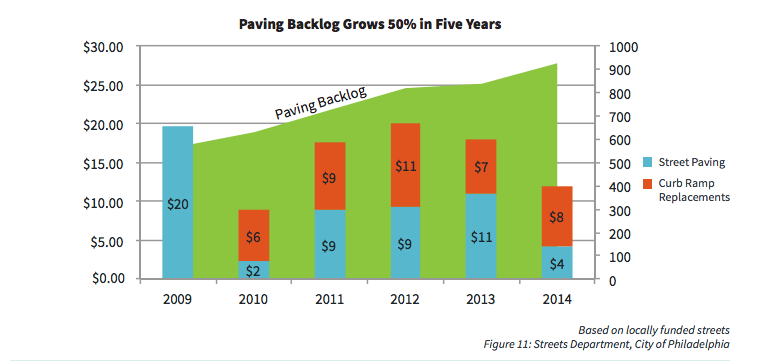It’s a good day to bone up on the City’s paving budget to better understand what this means for bike lanes and road conditions. Mayor Nutter is scheduled to give his budget address to City Council later this morning, and we’re going to be listening to find out how much he dedicates to paving.
Last year, Mayor Nutter bumped up the Streets Department’s paving budget for Fiscal Year 2015 (in the Capital Plan) from $12 million (in FY2014) to $16 million. According to the Streets Department, that amount should allow them to pave roughly 60 miles of streets in the 2015 paving season.
Sixty miles is a lot more than 25 miles — which is the number of miles that got repaved in 2013 and 2014 — but it’s less than half of what the Streets Department should be repaving on an annual basis: 139 miles.
It’s important to put these figures in some perspective.
Between 2009 and 2014, the financial crisis and judicially mandated American with Disabilities Act (ADA) curb ramps, decimated the paving budget for five years, creating a 900 mile backlog of streets that remains to be repaved.

The rule of thumb is that roads should be repaved between every 7-10 years, but in Philadelphia, that cycle has slipped, significantly. In fact, Philadelphia’s roads are typically only getting repaved every 15 years.
Here are a few facts to store into your memory bank: Philadelphia has roughly 2500 miles of roads. A portion of them are state roads. PennDOT paves state roads. The City is responsible for paving its own “local roads.” The feds chip in to help pay for local road paving. The bulk of the cost is borne by the City of Philadelphia and specifically, the Streets Department.
Interestingly enough, in the 5-Year Financial and Strategic Plan FY15-19, the City’s “Technology Improvements” capital line item was $29 million; $13 million more than the $16 million paving budget. That’s an indication of how paving stacks up against other city priorities.
Going forward, the Streets Department will limit what it spends on curb ramps to those that have been identified as the most important to the disabled community. Hopefully, this will free up more of the paving budget to pave roads.
Why should you care? Because when roads get repaved, that’s when new bike lanes can get installed. Roads that get repaved get a pavement marking plan and those plans tell the stripping crew where to lay down thermoplast, thus creating a bike lane. The City’s 2012 Pedestrian/Bicycle master plan proposed where new bike lanes should go in order to build out the bicycle network. So, when the Streets Department puts together its paving program in the fall/winter before the paving season begins, a cross-check between the roads slated to be repaved and the Bicycle Network plan needs to occur in order to ensure that bike lanes get included on a road’s pavement marking plan. Consequently, the fewer miles of roads that get repaved, the less bike lanes get installed.
The Bicycle Coalition and its partners have proposed in the Better Mobility platform that the next mayor should should commit to a doubling of the bike lane installation rate from 6 miles a year (the average number of miles of lanes installed between 2008-2013) to 15 miles of new bike lanes annually. Philadelphia lags behind its peer cities in terms of lane installation.

Rate of bike lane miles added by city. Centerline miles for Chicago and DC only*
To learn more about paving budgets and and the Better Mobility 2015 platform, check out our page on Better Mobility in Philadelphia’s 2015 elections, and don’t forget to RSVP to our Better Mobility 2015 mayoral forum, at the Friends Center on March 19.

Here’s an idea: shut down some streets and make them bike-only with posts at the head-end! 🙂 Sure, bicyclists need good pavement too, but narrower, and the lack of heavy vehicles, plowing, and salting would make it last longer too.